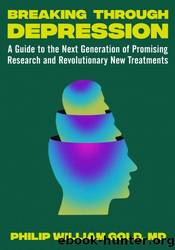Breaking Through Depression by Philip William Gold

Author:Philip William Gold [WILLIAM GOLD, MD, PHILIP]
Language: eng
Format: epub
Published: 2023-08-15T00:00:00+00:00
CHAPTER 10
When Children Suffer
In some cases, sadly, depression can manifest at a very young age. Two to 3 percent of children from the ages of three to eleven develop a true depression. Depression in children is more severe than normal sadness and can significantly interfere with a childâs capacity to function. We now know that three- and four-year-old children are capable of considerably more sophisticated emotional experiences than what had been previously thought and are subject to the feelings we recognize more generally in depression, such as guilt and shame. This is often accompanied by feelings of irritabilityâmore so than that seen in adultsâintense loneliness, loss of social interests, increased sensitivity to rejection, and changes in appetite and sleep. Other issues often include difficulty in concentrating, lack of interest or participation in events with friends, fatigue, boredom, and severe pessimism.
Relatively few neuroimaging studies have been performed on children suffering from depression, but studies unsurprisingly reveal findings similar to what we see in adults: a significant decrease in the size of the emotional memory center and a subtle decrement in overall brain size. Children who have a first-degree relativeâparent or siblingâwith major depressive illness show a controller that is reduced in size, while the size of the amygdala is increased. These changes are also similar to those seen in adults with depression, and they significantly contribute to symptoms.
Children with mild depression are usually treated with psychotherapy alone. If the depressive symptoms do not begin to improve within six to eight weeks, or if symptoms worsen, an antidepressant medication may be recommended. Children with moderate to severe depression generally require psychotherapy and one or more medications. This is called combination therapy. Treatment with combination therapy increases the likelihood of improved symptoms and relationships with family and friends; it can also improve self-confidence and the ability to cope effectively.
Unfortunately, bipolar disorder also occurs in children aged three to eleven. In children, manic states are accompanied by grandiosity, rapid speech, decreased need for sleep, and even more irritability than is seen in manic adults. Sometimes confusing matters, the severe chronic irritability, hyperarousal, and hyperreactivity that characterize pediatric bipolar disorder can also occur in ADHD. One thing that distinguishes bipolar disorder from ADHD is that mania is intermittent in bipolar disorder, alternating with depressive episodes and apparent remission. In ADHD, symptoms are continuous, without interruption.
Bipolar disorder in children can be effectively treated with lithium. Anticonvulsants can also be used, and itâs generally best to avoid antidepressants, since they can precipitate mania.
Adolescent Depression and Bipolar Disorder
In 2014, an estimated two million adolescents aged twelve to seventeen in the United States had at least one major depressive episode in the past year with severe impairment. This number represented 8.2 percent of the population aged twelve to seventeen. By the end of adolescence, an astounding 20 percent will have had one serious episode during their adolescence. This serious illness is the second greatest cause of mortality in this age group.
Depression in adolescence also predicts a range of mental
Download
This site does not store any files on its server. We only index and link to content provided by other sites. Please contact the content providers to delete copyright contents if any and email us, we'll remove relevant links or contents immediately.
Rewire Your Anxious Brain by Catherine M. Pittman(17599)
Talking to Strangers by Malcolm Gladwell(11905)
The Art of Thinking Clearly by Rolf Dobelli(8862)
Mindhunter: Inside the FBI's Elite Serial Crime Unit by John E. Douglas & Mark Olshaker(7848)
Becoming Supernatural by Dr. Joe Dispenza(7119)
Change Your Questions, Change Your Life by Marilee Adams(6654)
The Road Less Traveled by M. Scott Peck(6646)
Nudge - Improving Decisions about Health, Wealth, and Happiness by Thaler Sunstein(6642)
The Lost Art of Listening by Michael P. Nichols(6481)
Enlightenment Now: The Case for Reason, Science, Humanism, and Progress by Steven Pinker(6414)
Win Bigly by Scott Adams(6327)
Mastermind: How to Think Like Sherlock Holmes by Maria Konnikova(6250)
The Way of Zen by Alan W. Watts(5809)
Daring Greatly by Brene Brown(5651)
Grit by Angela Duckworth(4746)
Big Magic: Creative Living Beyond Fear by Elizabeth Gilbert(4734)
Men In Love by Nancy Friday(4339)
Flow by Mihaly Csikszentmihalyi(4060)
The Four Tendencies by Gretchen Rubin(4028)
